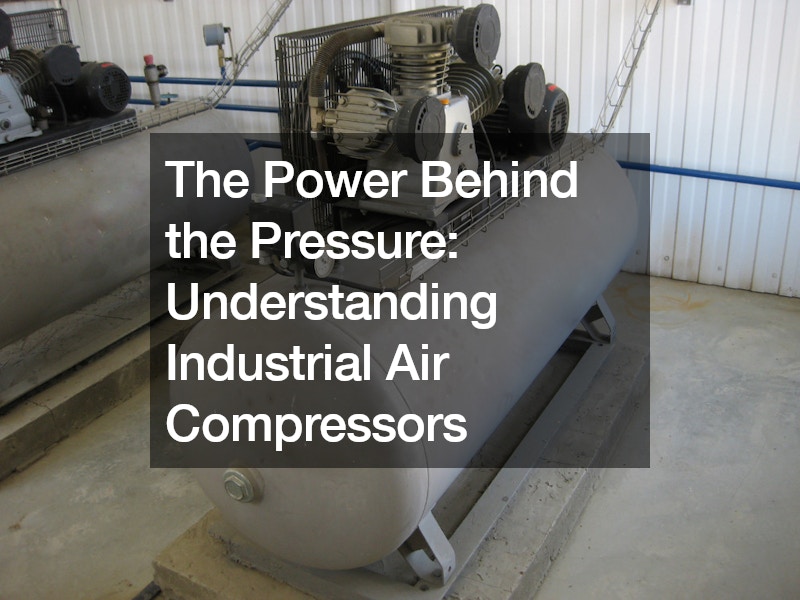
Industrial facilities rely on a constant stream of compressed air to power various tools and equipment. From operating assembly lines to cleaning machinery, a dependable industrial air compressor is a vital workhorse. But how exactly does compressed air come to be, and what factors should be considered when choosing the right industrial air compressor?
This article dives into the world of industrial air compressors, exploring their working principles, different types, and key selection criteria.
How Air Becomes Compressed: Positive Displacement Takes Center Stage
Most industrial air compressors utilize the principle of positive displacement.
In simpler terms, they reduce the volume of air in a chamber, thereby increasing its pressure. This compressed air is then stored in a tank for later use.
One of the most common types of positive displacement compressors is the reciprocating compressor. Imagine a piston moving back and forth within a cylinder. During the intake stroke, the piston creates a low-pressure zone, allowing air to flow into the cylinder. As the piston moves back (compression stroke), the air volume gets squeezed, raising the pressure.
For applications requiring even higher pressure, multi-stage reciprocating compressors are employed. These have multiple pistons, each compressing the air further in stages, resulting in a higher overall pressure output.
Another positive displacement design is the diaphragm compressor. Similar to the reciprocating compressor, it uses a piston, but a diaphragm separates the compressed air from the lubricated parts, making it ideal for applications where oil-free air is critical, such as in the food and beverage industry.
A Different Approach: Rotary Compressors Offer Smooth Flow
Rotary compressors offer an alternative approach to air compression. Instead of pistons, they use rotating components, like vanes or screws, to trap and compress air within chambers. The continuous rotation allows for a smoother, pulsation-free flow of compressed air, making them suitable for applications requiring consistent pressure. Additionally, rotary compressors are generally quieter and more compact than their reciprocating counterparts.
Choosing the Right Industrial Air Compressor: Key Considerations
Selecting the right industrial air compressor hinges on several factors, including:
Air Demand: Identify the required volume (CFM – cubic feet per minute) and pressure (PSI) of compressed air your equipment needs. It’s crucial to choose a compressor with sufficient capacity to handle peak demand without strain.
Duty Cycle: Consider how frequently the compressor will be used. Continuous-duty compressors are ideal for long periods of operation, while intermittent-duty machines are suitable for tasks with shorter bursts of activity.
Power Source: Industrial air compressors can be electric, gasoline, or diesel-powered. Electric models are generally quieter and require less maintenance, but may be limited by available power outlets. Gasoline and diesel options offer greater portability but generate noise and require stricter emission regulations.
Air Quality: Determine if oil-free air is necessary for your application. Oil-injected compressors are more common and offer higher efficiency, but the oil can contaminate the air stream. Oil-free compressors are ideal for tasks requiring clean air, such as in food processing or electronics manufacturing.
Cooling System: Air compressors generate heat during operation. Choose a model with an efficient cooling system, such as air-cooled or water-cooled, to prevent overheating and maintain optimal performance.
Maintenance Needs: Consider the ease and frequency of maintenance required for different types of compressors. Regularly scheduled maintenance is essential for maximizing compressor lifespan and performance.
Additional Considerations: Noise Levels and Mobility
Noise levels can be a significant factor in industrial settings. Rotary compressors generally operate quieter than reciprocating models. Additionally, consider the portability needs. If the compressor needs to be moved frequently, a more compact and lightweight design might be preferable.
Conclusion: Selecting the Perfect Partner for Your Industrial Needs
Industrial air compressors are the workhorses behind numerous industrial processes. Understanding the different types, their working principles, and key selection criteria empowers you to choose the right compressor for your specific requirements. By considering factors like air demand, duty cycle, power source, air quality, cooling system, maintenance needs, noise levels, and mobility, you can ensure your industrial operation has the reliable compressed air source it needs to function efficiently and effectively.
.




